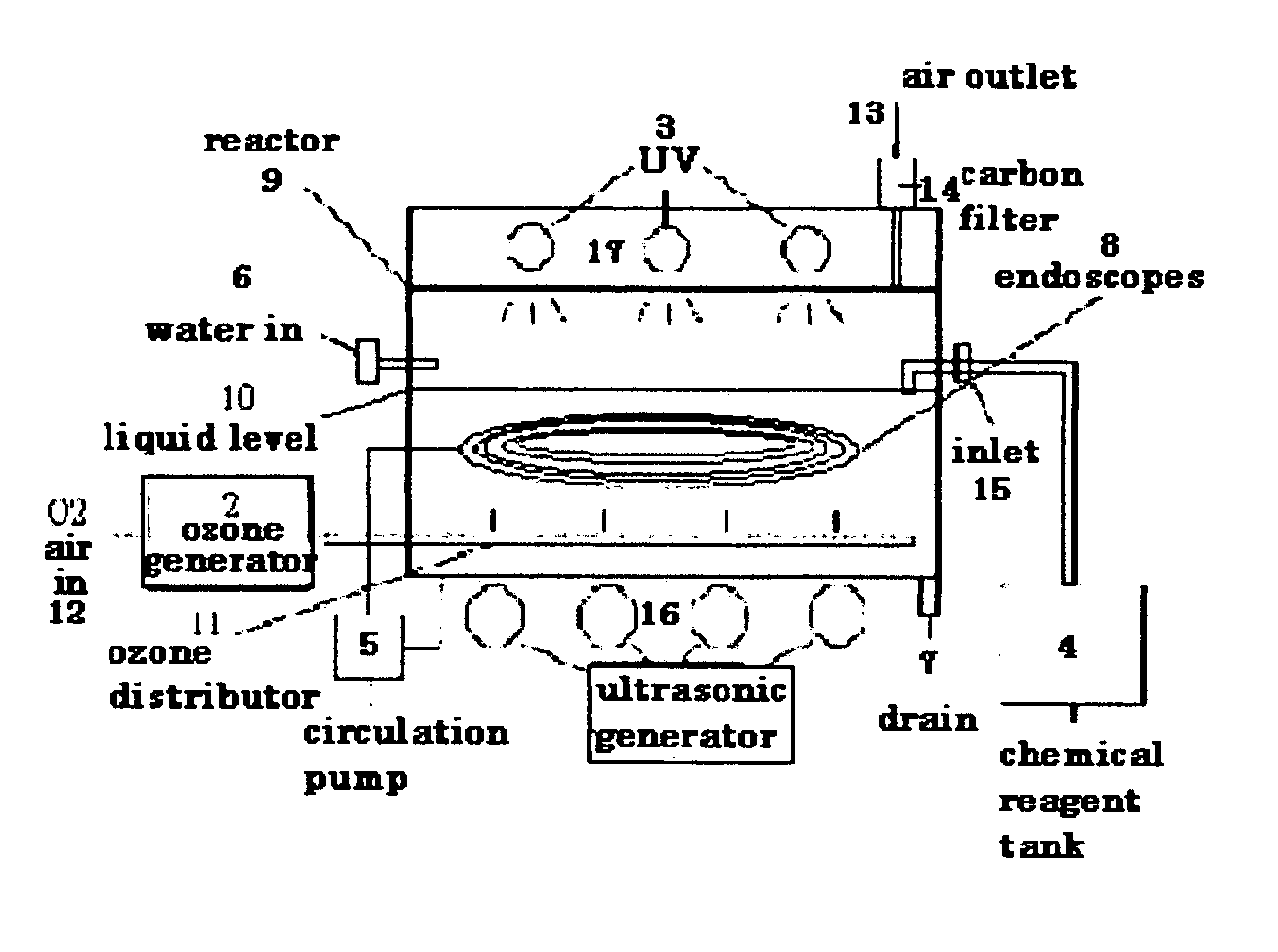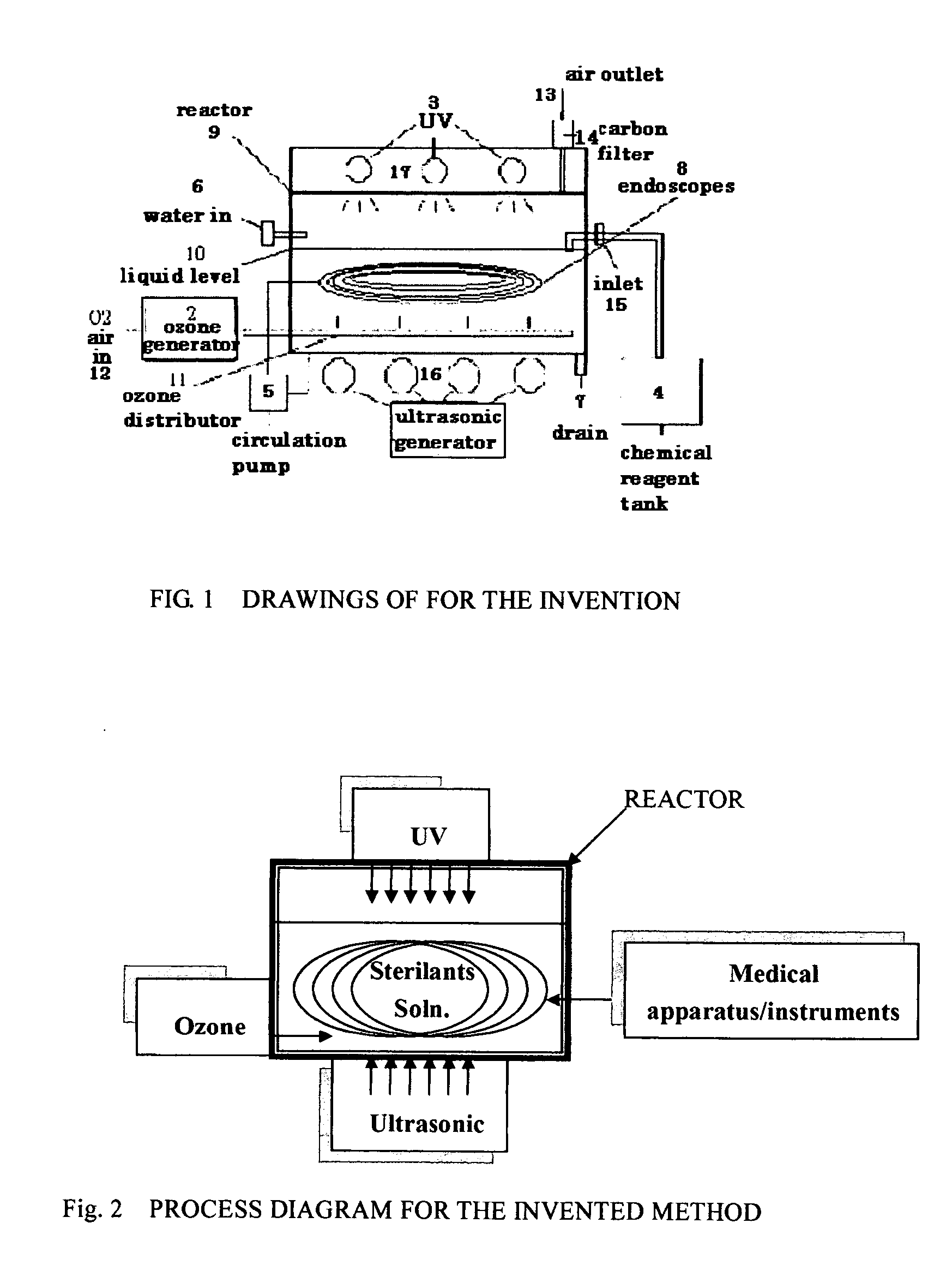It has been quite common in the medical field to re-process used medical apparatus and instruments, due to the cost of such medical apparatus and instruments.
The problem often occurs in conventional medical practices of reprocessing used medical apparatus / instruments with bacterial spores adsorbed to the complicated designed medical lumen—predominately but not limited to endoscopes.
Even so, due to the complicated design of contemporary endoscopes, the lumen hollow tubing and joints are hard to clean and
cross infections are often observed and sometimes results in deaths and legal disputes.
Flexible endoscopes have fragile parts, are easily damaged at high temperatures and are very expensive.
So they cannot be autoclaved and instead must be decontaminated by cleaning at low temperatures and disinfections.
A major problem with conventional endoscopes
washer-disinfectors is that they simply sit and soak endoscopes in the disinfectants or sterilant, which does not ensure the removal nor destruction of all living organisms adhered thereto.
However,
cross infection and medical dispute cases are often heard still, due to many studies showing that the simple flushing technique does not ensure the complete removal and destruction of complicated bacterial spores.
Disposal of contaminated medical apparatus / instruments would be the best practice to prevent cross
contamination problems; however, the high cost and complicated design of many medical apparatus / instruments have prevented this effective option.
However, the above mentioned existing flushing technologies along with sterilant or disinfectants do not provide adequate desorbing mechanisms for contaminates and microorganisms attached to the complicated lumen tubing joints and crevices, and often result in cross-infection and even deaths.
While such sterilization methods are very effective for more resilient medical apparatus / instruments, more sensitive medical apparatus / instruments made of rubber and
plastic materials with adhesives will be damaged by the high
temperature and pressure steam
autoclave.
In particular, the costly complex instruments such as endoscopes may be destroyed or have their useful lives greatly shortened by high
temperature and pressure thermal sterilization methods.
Further, endoscopes present particular problems in that such devices typically have numerous exterior crevices and interior lumens that can retain microbes and hence difficult to clean and sterilize using conventional flushing techniques along with disinfectants or sterilant such as Cidex,
Glutaraldehyde,
Hydrogen peroxide, Alcohols,
Ethylene oxide,
Formaldehyde, and Peracetic acids etc.
So far, efforts to sterilize more sensitive
medical instruments, such as endoscopes, have met with limited success and all conventional methods have associated problems or detractions.
The pressurization and depressurization cycles of
ethylene oxide sterilization may damage lens systems and other delicate instruments that are commonly integral with endoscopes.
Technician variation in the mixing, timing, and equipment handling raises problems of assurance and reproducibility of the manual disinfections process.
Rinsing of the items to remove chemical residues also adds a variable that reduces the assurance of disinfections or
sterility.
Once, rinsed, the disinfected endoscopes or other item is susceptible to recontamination by airborne microbes.
Further, merely soaking endoscopes in a sterilant or
disinfectant is unacceptable since numerous pockets exist within the tubing that the sterilant or detergent cannot reach effectively.
Accordingly, an ineffective effort to sterilize endoscopes by merely soaking is unacceptable.
A major drawback of this type of process is the lack of assurance of a sufficient flow of sterilant and
rinse water through the interior passages of the instrument.
The simple circulation of the liquid sterilant in the cassette or tray and the numerous pockets inherent in such a tubular instrument provides no assurance that adequate sterilization is attained in the interior passages of the instrument.
Because of this, the circulation liquid sterilization systems, which rely on complete submersion of the endoscopes, may also be inadequate to assure complete sterilization of all exterior surfaces.
Ethylene oxide tends to be very effective against a wide range of microorganisms, but it is highly flammable, longer
process time as mentioned previously and is generally used in a
gas phase which may require more stringent environmental restraints than would a liquid.
Alcohols are similarly flammable and must be used in very high concentrations.
Steam has a more limited utility, having to be used in a controlled and enclosed environment, requiring the use of large amounts of energy to vaporize the water, and requiring
prolonged exposure periods to assure extended high temperature contact of the steam with the organisms.
Hydrogen peroxide has limited applicability because it is unstable and not as strong as some other sterilant.
However, the flushing of sterilant presents the same associated problem encountered due to interior air pockets and lack of
quality assurance for completely removal of the interior lumen microorganisms.
Sterilization can destroy all forms of life, including bacterial spores, the living organisms most resistant to sterilant.
 Login to View More
Login to View More 

